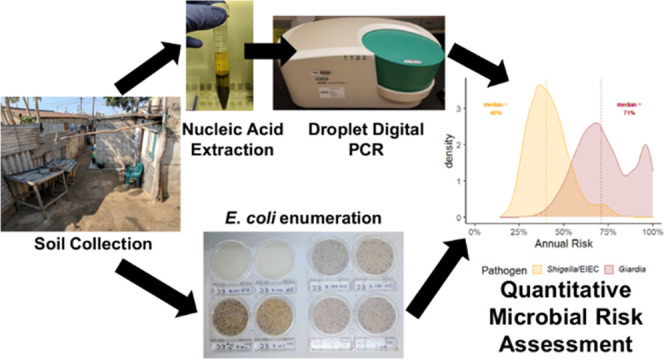- Record: found
- Abstract: found
- Article: not found
Quantitative Microbial Risk Assessment of Pediatric Infections Attributable to Ingestion of Fecally Contaminated Domestic Soils in Low-Income Urban Maputo, Mozambique

Read this article at
Abstract

Rigorous studies of water, sanitation, and hygiene interventions in low- and middle-income countries (LMICs) suggest that children are exposed to enteric pathogens via multiple interacting pathways, including soil ingestion. In 30 compounds (household clusters) in low-income urban Maputo, Mozambique, we cultured Escherichia coli and quantified gene targets from soils ( E. coli: ybbW, Shigella/ enteroinvasive E. coli (EIEC): ipaH, Giardia duodenalis: β-giardin) using droplet digital PCR at three compound locations (latrine entrance, solid waste area, dishwashing area). We found that 88% of samples were positive for culturable E. coli (mean = 3.2 log 10 CFUs per gram of dry soil), 100% for molecular E. coli (mean = 5.9 log 10 gene copies per gram of dry soil), 44% for ipaH (mean = 2.5 log 10), and 41% for β-giardin (mean = 2.1 log 10). Performing stochastic quantitative microbial risk assessment using soil ingestion parameters from an LMIC setting for children 12–23 months old, we estimated that the median annual infection risk by G. duodenalis was 7100-fold (71% annual infection risk) and by Shigella/EIEC was 4000-fold (40% annual infection risk) greater than the EPA’s standard for drinking water. Compounds in Maputo, and similar settings, require contact and source control strategies to reduce the ingestion of contaminated soil and achieve acceptable levels of risk.
Related collections
Most cited references91
- Record: found
- Abstract: found
- Article: not found
Burden and aetiology of diarrhoeal disease in infants and young children in developing countries (the Global Enteric Multicenter Study, GEMS): a prospective, case-control study.
- Record: found
- Abstract: not found
- Article: not found
fitdistrplus: AnRPackage for Fitting Distributions
- Record: found
- Abstract: found
- Article: not found
